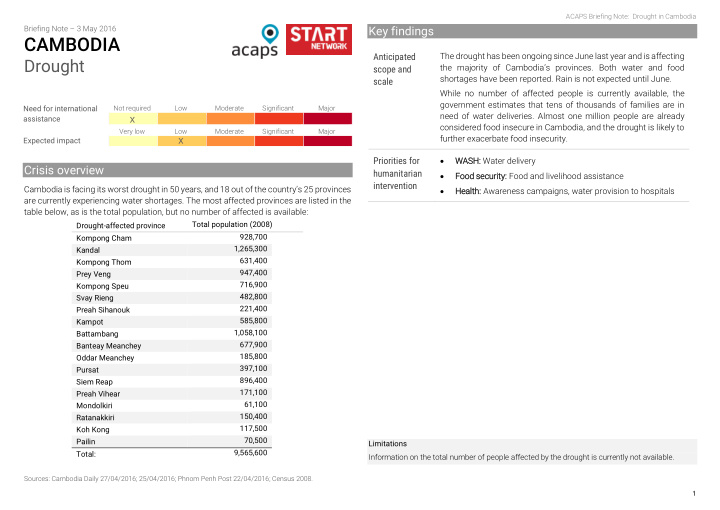



ACAPS Briefing Note: Drought in Cambodia Briefing Note – 3 May 2016 Key findings CAMBODIA Anticipated The drought has been ongoing since June last year and is affecting Drought the majority of Cambodia’s provinces . Both water and food scope and shortages have been reported. Rain is not expected until June. scale While no number of affected people is currently available, the government estimates that tens of thousands of families are in Need for international Not required Low Moderate Significant Major need of water deliveries. Almost one million people are already assistance X considered food insecure in Cambodia, and the drought is likely to Very low Low Moderate Significant Major further exacerbate food insecurity. Expected impact X Priorities for WASH SH: Water delivery Crisis overview humanitarian Food d se securi rity: Food and livelihood assistance intervention Cambodia is facing its worst drought in 50 years, and 18 out of the country’s 25 provinces Health: Awareness campaigns, water provision to hospitals are currently experiencing water shortages. The most affected provinces are listed in the table below, as is the total population, but no number of affected is available: Total population (2008) Drought-affected province 928,700 Kompong Cham 1,265,300 Kandal 631,400 Kompong Thom 947,400 Prey Veng 716,900 Kompong Speu 482,800 Svay Rieng 221,400 Preah Sihanouk 585,800 Kampot 1,058,100 Battambang 677,900 Banteay Meanchey 185,800 Oddar Meanchey 397,100 Pursat 896,400 Siem Reap 171,100 Preah Vihear 61,100 Mondolkiri 150,400 Ratanakkiri 117,500 Koh Kong 70,500 Pailin Limitations 9,565,600 Total: Information on the total number of people affected by the drought is currently not available. Sources: Cambodia Daily 27/04/2016; 25/04/2016; Phnom Penh Post 22/04/2016; Census 2008. 1
ACAPS Briefing Note: Drought in Cambodia Crisis impact 18 out of Cambodia’s 25 provinces are currently facing water shortages as a result of the worst drought in decades (Bangkok Post 26/04/2016). The drought began in June last year and is linked to the severe El Niño weather phenomenon, which has caused below- average rainfall across Cambodia (Phnom Penh Post 22/04/2016). According to forecasts, rainfall is not expected until June (Bangkok Post 26/04/2016). Temperatures have reached up to 41°C, and an increase in forest fires has been reported. Forest fires have been difficult to combat due to lack of water (Phnom Penh Post 02/05/2016; Reuters 26/04/2016). No number of affected people is currently available, but the government estimates that tens of thousands of families are in need of water deliveries (Cambodia Daily 25/04/2016). The government has not declared a state of emergency (Bangkok Post 26/04/2016). Source: FAO/GIEWS 23/09/2015 WASH SH: Water shortages are reported in 18 provinces, and the government has called on the population to restrict water usage (Bangkok Post 26/04/2016). As a result of water shortages, affected families have resorted to buying water from private vendors, Vulnerable groups affected exacerbating economic difficulties among the poor population (Phnom Penh Post 29/04/2016; Indigenous groups (around 1.4% of the population) are particularly vulnerable to Cambodia Daily 25/04/2016). Use of unsafe water is already highly prevalent in Cambodia’s drought conditions as they often rely on natural water sources and generally live in rural areas, and the drought is likely to have caused a further increase. In some affected remote areas where they cannot easily access water deliveries (Phnom Penh Post areas, people have reportedly stopped bathing and cleaning, which could pose health 24/03/2016). threats (Phnom Penh Post 24/03/2016). 80% of Cambodia’s population is rural, and particularly vulnerable to drought and Food se securi rity a and l live velihoods: Food shortages are reported in some provinces as a result water shortages due to the potential impact on their livelihoods. Water shortages are of the prolonged drought (Phnom Penh Post 29/04/2016). Farmers in the affected provinces further disproportionally affecting the poor, who have to spend already limited are reported to have insufficient water to irrigate their crops (Bangkok Post 26/04/2016). The income on buying water from private vendors (Phnom Penh Post 29/04/2016; Cambodia Daily dry conditions that affected Cambodia in June and August 2015 reduced rice production 25/04/2016). by an estimated 2% compared to the previous year’s harvest, however the 2015 production is still estimated to be above the five year-average. Cambodia generally Humanitarian and operational constraints produces twice the amount of rice needed to feed its population – however 70% of the No humanitarian or operational constraints have been reported by organisations working population depend primarily on agriculture and livestock as main source of income, and in the affected provinces. the drought is likely to impact their livelihoods (WFP 31/03/2016; ACF 31/12/2015). Some farmers in the northwest were reportedly left without any rice harvest in 2015 (Phnom Penh Aggravating factors Post 22/04/2016). An unknown number of livestock has died, and declining water levels in lakes are reducing the number of fish (Phnom Penh Post 02/05/2016). Underlying food insecurity and malnutrition Health: While no outbreaks of water- or vectorborne diseases are yet to be reported, An estimated 980,000 people are considered to be food insecure in Cambodia. Chronic authorities are concerned about the increased risk of diarrhoea, dengue, and cholera food insecurity is perpetuated by limited access to education and health services among outbreaks (Cambodia Daily 25/04/2016). High fevers and skin irritation caused by the heat have poor people, and low investment in public infrastructure. Micronutrient deficiencies are been reported (Phnom Penh Post 29/04/2016). Hospitals have reported that lack of water widespread, and 32% of children under five suffer from chronic malnutrition (Save the impacts their ability to provide adequate health services (Phnom Penh Post 29/04/2016). Children 26/04/2016; WFP 31/03/2016). 2
Recommend
More recommend